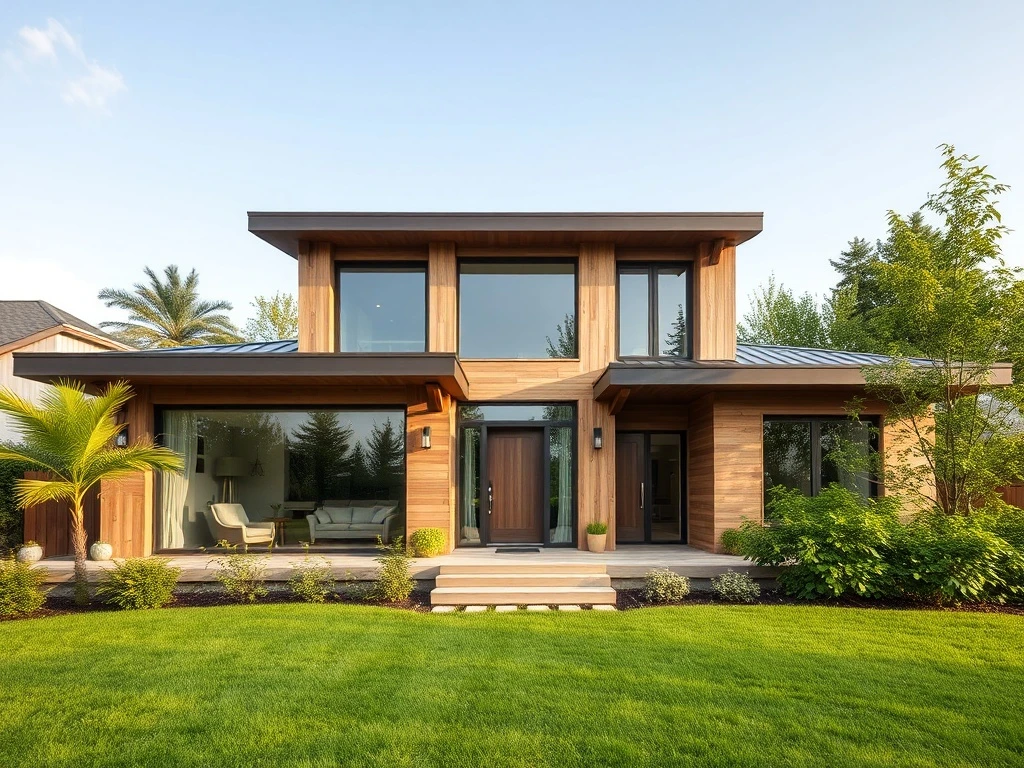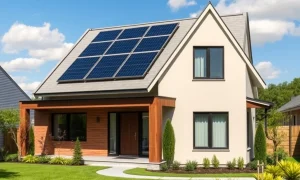The global conversation around climate change and environmental health grows louder each day. Homeowners increasingly seek ways to minimize their environmental footprint. This shift leads to a rising demand for materials and techniques supporting energy conservation, improving indoor air quality, and promoting well-being. Selecting appropriate sustainable building materials allows homeowners to create comfortable, efficient living spaces while making a positive environmental impact.
Understanding Sustainable Building Materials
Sustainable building materials are derived from renewable resources, designed for reuse, or produced through environmentally friendly processes. These materials aim to reduce energy consumption and increase sustainability in construction practices. Key characteristics include low environmental impact, exceptional durability, and the ability to be responsibly sourced. They often involve materials that are recycled, reclaimed, or certified by recognized sustainability standards. For instance, the Forest Stewardship Council (FSC) certifies wood from responsibly managed forests.
Among the various options, wood remains a prevalent sustainable building material. Using timber from responsible harvesting practices helps builders create energy-efficient structures. Premium wood materials offer a blend of style and functionality, aligning with environmental responsibility. Furthermore, incorporating diverse materials enhances a building’s sustainability profile. These include:
- Bamboo: Rapidly renewable, ideal for flooring and cabinetry.
- Recycled Metal: Strong, durable, and reduces demand for virgin ore.
- Reclaimed Brick: Offers unique aesthetics and prevents landfill waste.
- Cellulose Insulation: Made from recycled paper, excellent thermal performance.
- Cork: Natural, renewable, and provides acoustic and thermal insulation.
- Straw Bales: An agricultural byproduct, offers high insulation value.
Using local materials also reduces transportation emissions and supports regional economies. Advances in manufacturing technology lead to innovative products that combine sustainability with high performance. Life cycle assessments (LCAs) help determine the long-term environmental benefits of chosen materials. They evaluate environmental impacts from raw material extraction through processing, manufacturing, distribution, use, repair, and disposal or recycling.
Enhancing Energy Efficiency with Sustainable Building Materials
The role of sustainable building materials extends beyond mere aesthetics. One primary benefit lies in their superior insulation properties. Effective insulation minimizes heat loss in winter and keeps homes cooler during summer. Specific sustainable building materials offer superior insulation properties:
- Cellulose: Made from recycled paper, it provides excellent thermal resistance and can regulate humidity.
- Sheep’s Wool: A natural, renewable fiber that offers high R-value and breathability.
- Recycled Denim: Made from post-consumer cotton scraps, it’s non-toxic and performs well.
- Rigid Foam (Recycled Content): While some foams are petroleum-based, options with high recycled content offer strong insulation.
- Aerogel: A highly advanced material known for its exceptional thermal resistance in thin applications.
A well-insulated home results in significant energy savings. Studies show homes with high insulation values can reduce heating and cooling costs by up to 50 percent compared to poorly insulated homes. This lessens the financial burden on homeowners and conserves energy. Quality insulation contributes to thermal comfort by maintaining stable indoor temperatures. This ensures a cozy atmosphere regardless of exterior conditions.
Beyond Traditional Insulation
Beyond conventional wall and attic insulation, sustainable materials impact overall building envelope performance. For example, high-performance windows with multiple panes and low-emissivity coatings drastically reduce heat transfer. Green roofs, utilizing a layer of vegetation, provide natural insulation. They also mitigate urban heat island effects. Similarly, phase-change materials (PCMs) integrated into building components absorb and release heat, stabilizing indoor temperatures. These advancements contribute significantly to reducing a home’s energy footprint. They ensure long-term efficiency and comfort.
Improving Indoor Air Quality with Sustainable Building Materials
Indoor air quality (IAQ) is another important element directly influenced by the choice of building materials. Many traditional building materials contain volatile organic compounds (VOCs). These can lead to various health issues, ranging from allergies to more severe respiratory conditions. Opting for sustainable building materials mitigates these risks. They minimize or eliminate the use of harmful chemicals. For example, low-VOC paints, adhesives, and sealants significantly reduce airborne toxins.
Bamboo has gained popularity in flooring and cabinetry. Bamboo is rapidly renewable and naturally resistant to mold and pests. This adds a layer of health benefits. Natural linoleum, made from linseed oil, cork, and wood flour, offers a durable, biodegradable, and non-toxic flooring alternative. Studies indicate that homes built with sustainable materials can improve air quality significantly. Ultimately, this contributes to better health for occupants and reduces the risk of chronic illnesses. Proper ventilation strategies, often integrated into sustainable designs, further enhance IAQ by circulating fresh air and expelling pollutants.
Maximizing Natural Light and Well-being with Sustainable Building Materials
Incorporating sustainable building practices can dramatically improve a home’s use of natural light. Strategic window placement, the use of skylights, and light tubes enhance daylighting. This reduces the need for artificial lighting. It promotes a more energy-efficient living environment. Natural light contributes positively to mental well-being, enhancing mood and productivity. Designers often incorporate passive solar design principles. They leverage the sun’s energy to provide heat and light. This leads to reduced energy costs while creating a brighter, more inviting space.
Research indicates that even small adjustments to maximize daylight in a home can lead to significant energy savings. Many households report reduced utility bills. Beyond energy savings, abundant natural light connects occupants with the outdoors. This fosters a sense of openness and vitality. Thoughtful window design, including optimal sizing and shading, balances light admission with heat gain or loss. This ensures year-round comfort.
Long-Term Cost Benefits of Sustainable Building Materials
While the initial investment in sustainable building materials may sometimes appear higher than traditional options, the long-term cost benefits far outweigh this upfront cost. Increased energy efficiency directly leads to lower utility bills. Furthermore, the inherent durability of many sustainable materials often means less frequent replacements or repairs. This reduces maintenance expenses over the home’s lifespan.
Many states and local governments offer incentives for homeowners who invest in energy-efficient upgrades. These can include tax credits, grants, and rebates, providing additional savings. An important consideration is the long-term value of a home. Properties constructed with sustainable materials often appreciate more quickly. They appeal strongly to environmentally conscious buyers in a competitive market. Homeowners can view their investment in sustainability not merely as an expense but as a strategic decision. This decision significantly enhances the enduring value of their property. Over a 10-20 year period, the cumulative savings from reduced energy consumption and maintenance can be substantial. This makes sustainable construction a financially sound choice.
Durability and Resilience of Sustainable Building Materials
Many sustainable building materials boast superior durability and resilience compared to their conventional counterparts. This inherent strength contributes significantly to a home’s longevity and reduced maintenance needs. For instance, reclaimed timber, often sourced from old industrial buildings, has already weathered decades of use. This makes it incredibly stable and resistant to warping. Similarly, high-density bamboo flooring is remarkably hard and resistant to scratches.
Natural materials like stone and brick offer exceptional fire resistance and thermal mass. This helps regulate indoor temperatures and withstand extreme weather conditions. Recycled steel and concrete, when properly engineered, provide robust structural integrity. They also minimize the demand for virgin resources. These durable options ensure that homes built with sustainable materials stand the test of time. They require fewer repairs and replacements. This further reduces their environmental footprint over their entire life cycle.
Water Conservation Through Sustainable Building Practices
Beyond energy and air quality, sustainable building materials and practices play a crucial role in water conservation. Implementing strategies like rainwater harvesting systems allows homeowners to collect and store rainwater for non-potable uses. These uses include irrigation, toilet flushing, and laundry. Permeable pavements, made from materials like recycled rubber or porous concrete, allow rainwater to infiltrate the ground. This reduces stormwater runoff and replenishes groundwater tables.
Furthermore, selecting water-efficient fixtures, such as low-flow toilets and showerheads, significantly reduces indoor water consumption. Drought-tolerant landscaping, incorporating native plants, minimizes the need for irrigation. This preserves precious water resources. These combined efforts create homes that are not only energy-efficient but also water-smart. This contributes to broader ecological health.
Community and Environmental Impact of Sustainable Building Materials
The benefits of choosing sustainable building materials extend far beyond the individual home. This approach fosters a positive impact on local communities and the wider environment. Sourcing materials locally supports regional economies and reduces transportation emissions. This minimizes the carbon footprint associated with construction. Furthermore, prioritizing recycled or reclaimed materials diverts waste from landfills. This conserves valuable landfill space and reduces pollution.
Sustainable construction practices often involve less disruptive processes. They minimize noise and dust pollution during building. This creates healthier environments for construction workers and surrounding neighborhoods. Ultimately, embracing sustainable building contributes to a circular economy. Resources are reused and recycled, reducing reliance on finite virgin materials. This creates a more resilient and environmentally responsible built environment for everyone.
Choosing sustainable building materials is far more than an eco-friendly decision; it profoundly influences home efficiency and comfort. From enhancing energy efficiency through superior insulation to improving indoor air quality and maximizing natural light, the benefits are numerous and impactful. As the world shifts toward a more sustainable future, homeowners prioritizing these materials will find themselves saving money, contributing positively to the environment, and increasing their property’s value. Embracing sustainable building practices ensures a healthier, more comfortable, and efficient home for generations to come.
Frequently Asked Questions (FAQs)
Q1: What defines a building material as “sustainable”?
A1: A building material is considered sustainable if it comes from renewable resources, is designed for reuse or recycling, or is produced through environmentally responsible processes that minimize negative impacts on the environment and human health.
Q2: Are sustainable building materials more expensive initially?
A2: While the upfront cost of some sustainable materials can be higher, their long-term benefits often outweigh this. These benefits include significant savings on energy bills, reduced maintenance, increased durability, and potential government incentives, leading to a lower total cost of ownership over time.
Q3: How do sustainable materials improve indoor air quality?
A3: Sustainable materials typically contain fewer volatile organic compounds (VOCs) and other harmful chemicals found in traditional materials. This reduces airborne toxins, minimizes allergens, and promotes a healthier indoor environment, leading to better respiratory health for occupants.
Q4: Can existing homes be upgraded with sustainable building materials?
A4: Absolutely. Many sustainable materials and technologies can be incorporated into existing homes during renovations or upgrades. Examples include adding natural insulation, replacing windows with energy-efficient models, installing low-VOC paints, or upgrading to water-saving fixtures.
Q5: What are some common examples of sustainable building materials?
A5: Common examples include responsibly sourced wood (FSC certified), bamboo, recycled steel, reclaimed brick, cellulose insulation (from recycled paper), sheep’s wool insulation, natural linoleum, cork, and low-VOC paints and sealants.
Q6: How do sustainable building materials contribute to a home’s long-term value?
A6: Homes built with sustainable materials often have lower operating costs, are more durable, and appeal to a growing market of environmentally conscious buyers. This can lead to faster appreciation and higher resale values compared to conventionally built properties.




